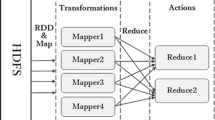Abstract
With the advent of new high-throughput next-generation sequencing technologies, the volume of genetic data processed has increased significantly. It is becoming essential for these applications to achieve large-scale alignments with thousands of sequences or even whole genomes. However, all current MSA tools have exhibited scalability issues when the number of sequences increases. The main drawback of these methods is that errors made in early pairwise alignments are propagated to the final result, affecting the accuracy of the global alignment. The use of consistency information enables the final result to be improved and makes it more stable from the accuracy point of view. However, such methods are severely limited by the memory required to store the consistency information. Authors in a previous work analyzed the structure and distribution of the data stored in the constraint library and demonstrated that it could be possible to reduce it without loosing accuracy, and thus it is possible to increase the number of sequences to be aligned. However, the execution time for obtaining the constraint library for a bigger number of sequences also increases greatly. In the present paper, the authors apply Big Data technologies to take advantage of the high degree of parallelism provided by the MapReduce paradigm in order to reduce considerably the library calculation time. Moreover, Big Data infrastructure provides a distributed storage system to improve the library scalability and machine-learning algorithms to enhance the consistency selection policies.





Similar content being viewed by others
Notes
T-Coffee-MEL sources and its installation instructions can be found at: github.com/jllados/TCoffee-MEL.
References
Dean J, Ghemawat S (2010) MapReduce: a flexible data processing tool. Commun ACM 53(1):72–77
Do C, Brudno M, Batzoglou S (2004) PROBCONS: Probabilistic Consistency-based multiple alignment of amino acid sequences. In: Proceedings nineteenth national conference on artificial intelligence, pp 703–708
Eddy SR (2009) A new generation of homology search tools based on probabilistic inference. Genome Inform 23:205–211
Gouy M, Guindon S, Gascuel O (2010) Seaview version 4: a multiplatform graphical user interface for sequence alignment and phylogenetic tree building. Mol Biol Evol 27(2):221–224
Gotoh O (1990) Consistency of optimal sequence alignments. Bull Math Biol 52(4):509–525
Just W (2001) Computational complexity of multiple sequence alignment with sp-score. J Comput Biol 8(6):615–623
Katoh K, Misawa K, Kuma K, Miyata T (2002) Mafft: a novel method for rapid multiple sequence alignment based on fast Fourier transform. Nucleic Acids Research 30(14):3059–3066
Karun AK, Chitharanjan K (2013) A review on hadoop—HDFS infrastructure extensions. In: IEEE Conference on Information & Communication Technologies, pp 132–137
Liu K, Linder CR, Warnow T (2010) Multiple sequence alignment: a major challenge to large-scale phylogenetics. PLoS Curr 2:RRN1198
Lladós J, Cores F, Guirado F (2017) Efficient consistency library for multiple sequence alignment tools. Int Conf Comput Math Methods Sci Eng 4:1269–1280
Marks DS, Hopf TA, Sander C (2012) Protein structure prediction from sequence variation. Nat Biotech 30(11):1072–1080
Notredame C, Higgins DG, Heringa J (2000) T-coffee: a novel method for fast and accurate multiple sequence alignment. J Mol Biol 302(1):205–217
Notredame C, Holm L, Higgins DG (1998) Coffee: an objective function for multiple sequence alignments. Bioinformatics 14(5):407–422
Pruesse E, Peplies J, Glöckner FO (2012) SINA: accurate high throughput multiple sequence alignment of ribosomal RNA genes. Bioinformatics 28(14):1823–1829
Sadasivam G, Baktavatchalam G (2010) A novel approach to multiple sequence alignment using hadoop data grids. Int J Bioinform Res Appl 6(5):472–483
Sakr S (2017) Big Data processing stacks. IT Prof 19(1):34–41
Sievers F, Dineen D, Wilm A, Higgins DG (2013) Making automated multiple alignments of very large numbers of protein sequences. Bioinformatics 29(8):989–995
Sievers F, Dineen D, Wilm A, Higgins DG (2013) Making automated multiple alignments of very large numbers of protein sequences. Bioinformatics 29(8):989–995
Subramanian AR, Weyer-Menkhoff J, Kaufmann M et al (2005) Dialign-T: an improved algorithm for segment-based multiple sequence alignment. BMC Bioinform 6:66
Thompson JD, Plewniak F, Poch O (1999) Balibase: a benchmark alignment database for the evaluation of multiple alignment programs. Bioinformatics 15(1):87–88
Wang L, Jiang T (1994) On the complexity of multiple sequence alignment. J Computat Biol 1(4):337–348
Zhang Y, Cao T, Li S, Tian X, Yuan L, Jia H, Vasilakos AV (2016) Parallel processing systems for Big Data: a survey. Proc IEEE 104(11):2114–2136
Zou Q, Hu Q, Guo M, Wang G (2015) HAlign: fast multiple similar DNA/RNA sequence alignment based on the centre star strategy. Bioinformatics 31(15):2475–2481
Acknowledgements
This work has been supported by the MEyC-Spain under contract TIN2014-53234-C2-2-R, TIN2017-84553-C2-2-R and TIN2016-81840-REDT.
Author information
Authors and Affiliations
Corresponding author
Rights and permissions
About this article
Cite this article
Lladós, J., Cores, F. & Guirado, F. Optimization of consistency-based multiple sequence alignment using Big Data technologies. J Supercomput 75, 1310–1322 (2019). https://doi.org/10.1007/s11227-018-2424-4
Published:
Issue Date:
DOI: https://doi.org/10.1007/s11227-018-2424-4




